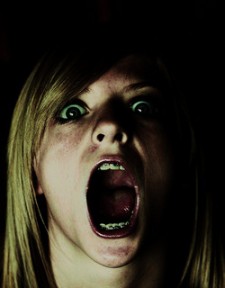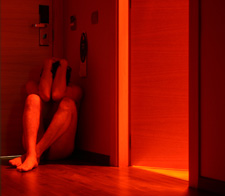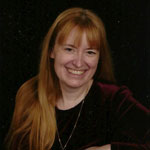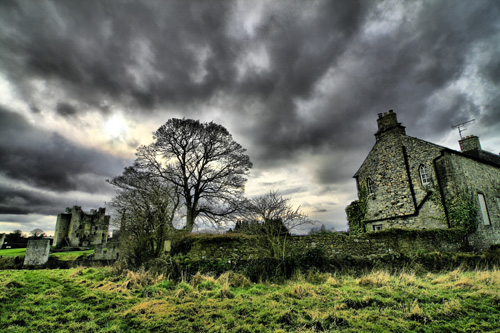Theme Essay by KC Redding-Gonzalez
The Scariest Monsters Don’t Have Fangs and Claws
It was a hot Georgia afternoon. I had a mean case of the flu. I was fifteen, so, like an idiot, I took my medicine, turned on the Tuesday lunchtime creature feature, and watched the single most frightening movie of my life: The Legend of Hell House.

The 1971 novel by Richard Matheson (titled Hell House) is very good, as I discovered when I read it two years later. But in my fevered, medicated state, John Hough’s 1973 film found ways into my darkest fears that no horror movie I've watched since has done.
I refuse—positively refuse—to see it again. But not for the reason you might think. The trouble for me, a writer of horror fiction, is that most film adaptations fail to scare the bejesus out of me. I remember The Legend of Hell House fondly for the true terror it induced, and I prefer not to know how cheesy it probably is.
I’m a bookworm, and I love my horror in deliberately measured increments. Hollywood’s reliance on special effects, lovingly detailed monsters, and predictable plots annoys my Lovecraftian nature. It tortures my gothic roots. Real fear in fiction is based on anticipation. What’s behind that locked door? Who cursed the family a thousand years ago—and why?
In contrast, horror films usually opt for sheer surprise (a gremlin leaping from a closet, spiders tumbling from the ceiling) to get us to jump in our seats. It’s all about the gut “ahhhh!,” rather than plot intricacies or revelations.
So, can a dedicated horror reader ever love horror films? Yes, especially when there’s no book to compare the movie to or if the gore is reduced to the role of punctuation. But I’ll go out on a limb here—a gnarled, claw-like limb—and say that if you really love the book, you’re going to despise the movie.
Reading engages the individual imagination; it’s intimate, private, internal. Horror films, on the other hand, are social experiencesdesigned to tap into group emotions. I would never deny that I’ve seen my share of powerfully scary movies. Some, like The Shining or Alien, even transcend the original book versions. But the audience for a horror film has very different expectations than those of us who grew up smuggling paperback novels by Stephen King, V.C. Andrews, Tanith Lee, or Clive Barker under the covers.
We dog-eared selected pages, reading those parts again and again with a flashlight, scaring ourselves every time. Here’s an excerpt from one of my favorite passages in Clive Barker’s 1987 novel Weaveworld:
On his second step something grazed his face. He stifled a cry of shock and put his hands up to find strands of matter in the air around his head. For some reason, he thought of phlegm—cold, wet threads of phlegm—except that they moved against his flesh as if they were a part of something larger—
The private experience of horror is intensely personal. It taps my memories; it raises my ghosts. In fact, when I read horror, the terror I feel often distorts my perception of what is really printed on the page. I tend to misremember scary books, recollecting details that are inexplicably missing from the part where I thought they were. I am still looking for a ghost that isn't there in The Shining when Danny is Big Wheeling down the hallways. (I’ve even checked both film versions, wondering if I imported it from one of them, but no.) I am always envisioning more of the monster than is revealed in fiction, always seeing glowing eyes in the dark.
When I write horror tales of my own, I know that readers will often transform what I’ve written based on their personal fears. Still, I focus on that creepy sensation in the pit of my stomach when I see something moving in the dark where nothing should be. Rather than a specific scene or plot device, it’s the sensation I care about evoking in readers.
Frankly, it’s not all the fault of filmmakers. Their uphill battle in satisfying a viewer like me is exacerbated by our wildly conflicting definitions of “scary."
I still relish the scene in Peter Straub's 1979 novel Ghost Story when members of the Chowder Society roam around dead Alma's decrepit house. But the 1981 film relied on star power (Fred Astaire, John Houseman, Alice Krige) and "characterizations" of horror that felt like parodies instead of the delicious dread engendered by the book. I hated the exaggerated facial expressions cast in dramatic lighting, especially whenever Dan or twin brother David (both played by Craig Wasson) were stalked by Alma’s ghost.
A writer like me can choose to exploit descriptive irregularities and ambiguous gaps left in prose, even create them at will; these are meant to seed horror in a slow I.V. drip. A filmmaker has a different set of artistic tools, ones meant to open the vein then and there with an all-out assault on the senses. Yet, the best horror films are based on the literary tradition of the gothic tale—The Woman in Black, The Shining, Misery, or The Orphanage—because it is simply more scary getting to the monster than actually seeing it.
Often, a filmmaker has no alternative but to drag a ghoul previously imagined in the anonymity of an individual reader’s mind out into the unforgiving light. But it’s not the stuntman lumbering about a miniaturized Tokyo in a 220-pound Godzilla suit that was scary in the early 1960s; it was the unknown effects of an anticipated nuclear war. An actor wrapped in a mummy suit may seem silly, but plenty of viewers harbor superstitious fear of disturbing the dead. Dismemberment still unnerves us in any chainsaw massacre. Ultimately, such anxieties are what creep us out, not tacky costumes and fake blood.

We’re likely hardwired to jump when something leaps at us out of the dark. More than anything, though, the disturbing thought that cannot be shaken is what gives me chills. The uneasiness may be collective; now I worry about extreme weather, genetic manipulation, viral plagues. But sometimes I’m most scared by my own inadequacies.
Consider this terrifying scene from Stephen King’s The Stand, when a boy’s simple act of forgetfulness has unintended, bloody consequences:
He had won the rabbit and a cage to keep him in at a school raffle. His daddy didn’t want him to keep it, but Lloyd had somehow persuaded him that he would take care of it and feed it out of his own allowance. He loved that rabbit, and he did take care of it. At first. The trouble was, things slipped his mind after a while. It had always been that way. And one day while he was swinging idly in the tire that hung from the sickly maple behind their scraggy little house in Marathon, Pennsylvania, he had suddenly sat bolt upright, thinking of that rabbit. He hadn’t thought of his rabbit in…well, in better than two weeks. It had just completely slipped his mind.
That’s why I prefer my horror from books; there’s no cutting room floor for what scares me most. I relish sliding slowly toward the inevitable conclusion. I savor the cold caress of tentacles as they reach into my own fears—and I love the lingering feel of them there.
Publishing Information
- Hell House by Richard Matheson (Viking Press, 1971).
- Weaveworld by Clive Barker (Poseidon Press/Simon & Schuster, 1987).
- The Shining by Stephen King (Random House, 1977).
- Ghost Story by Peter Straub (Coward, McCann, and Geoghehgan/Simon & Schuster, 1979).
- The Stand by Stephen King (Random House, 1978).
Art Information
- "Horror Scream Girl" © Sharon Pruitt; Creative Commons license
- "Ruin Stone Night" © Arvydas Kniukšta; stock image
- "Red Nightmare" © Daniel Diaz; stock image

KC Redding-Gonzalez is a blogger and writer of horror fiction preparing to graduate from the University of Colorado, Colorado Springs, with a B.A. in English/Professional and Technical Writing. She writes book reviews for Howlin’ Wolf Records Online Magazine and is a member of the Fiction Writer’s Guild, Science Fiction and Horror Dominion, and Horror Blogger’s Alliance.

